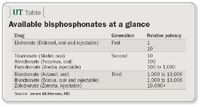Article
Bone density testing, treatment urged for men on ADT
A baseline bone density test to screen for osteoporosis, simple lifestyle changes to prevent osteoporosis from developing, and aggressive treatment if it develops are strongly recommended for men on androgen deprivation therapy (ADT) for advanced prostate cancer.

"The yearly bone loss in a normal aging male is 0.5% per year," Dr. McKiernan told colleagues at the Winter Urologic Forum here. "A retrospective analysis of six independent clinical studies shows that there is a 3% to 5% decrease in bone marrow density each year when a man has androgen deprivation therapy because of prostate cancer. For men on androgen deprivation therapy, bone loss doesn't stop and it doesn't plateau as long as there is a castrate-level serum testosterone level."
"Men with advanced prostate cancer can be expected to live longer and remain on androgen deprivation therapies for longer periods of time," added Mitchell C. Benson, MD, professor and chair of urology at Columbia. "As a result, osteoporosis now poses a significant quality and, on occasion, quantity of life issue to the man with advanced prostate cancer."
It takes about 2 to 4 years of continual hormone deprivation therapy to bring normal bone density to levels that constitute osteopenia and osteoporosis. For men on intermittent ADT, the risk of developing osteoporosis decreases significantly when testosterone is normalized between treatments.
To monitor a man's risk of developing osteoporosis during ADT, a bone density test is recommended at baseline and then every 2 years. Dr. McKiernan also recommended a few simple lifestyle changes to prevent osteoporosis from developing:
Bisphosphonate therapy
"When a patient is diagnosed with osteoporosis, there are no clear guidelines or recommendations about treatment," Dr. McKiernan said. "When someone has osteoporosis and needs to be on hormone deprivation therapy, they should also be taking a concomitant IV bisphosphonate."
Bisphosphonates are analogues of inorganic pyrophosphates that inhibit osteoclast activity. They are available in oral and IV formulations, and recent studies have examined the efficacy of both formulations.
One retrospective study of a prophylactic oral bisphosphonate showed it did not protect against accelerated ADT-induced bone loss in men with prostate cancer (J Clin Oncol 2006; 24:18s, abstract 14643). A short-term study of men with localized prostate cancer and ADT-induced bone loss compared those who received an IV bisphosphonate to men receiving placebo infusions, and showed that men in the treatment arm essentially maintained their baseline bone density, while those in the placebo arm showed a decrease in bone mineral density of about 2% at 1 year (N Engl J Med 2001; 345:948-55).
A 12-month randomized trial of the IV bisphosphonate zoledronic acid (Zometa) in men with recurrent or locally advanced prostate cancer on ADT showed a 6% increase in bone mineral density (J Urol 2003; 169:2008-12).
When it comes to osteoporosis and ADT, Dr. McKiernan stressed that awareness is key, followed by prevention and treatment.





